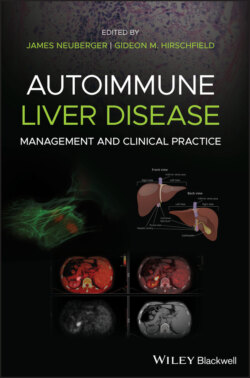Читать книгу Autoimmune Liver Disease - Группа авторов - Страница 45
Innate Immunity
ОглавлениеThe innate immune system responds immediately to PAMPs, comprising microbial constituents, and to DAMPs, comprising cellular constituents from stressed, neoplastic or dying cells (Table 2.2). Both PAMPs and DAMPs bind to pattern recognition receptors (PRRs) and other receptors expressed on neutrophils, dendritic cells (DCs), activated macrophages (including Kupffer cells), and natural killer (NK) and natural killer T (NKT) cells [3]. NK cells express killer receptors for stressed, dying or neoplastic cells and Fc receptors that mediate antibody‐dependent cell‐mediated cytotoxicity (ADCC) of target cells coated with antibodies [3]. Antigen‐presenting cells (APCs) activate NKT and γδT cells by invariant HLA class I‐like molecule (CD‐1) presentation of lipid or glycolipid antigens [3]. γδT cells protect from autoimmune diseases and microbial infections and participate in mucosal immunity and tumor surveillance.
Table 2.2 Comparison of selected features of innate and adaptive immunity.
| Innate immunity | Adaptive immunity | |
| Characteristics | ||
| Onset | Rapid responses mediated by preformed PRRs for microbial PAMPs and DAMPs | Delayed due to requirement for antigen activation, clonal proliferation and maturation of effector cell functions |
| Specificity | PAMPs, DAMPs, ROS, activated C′ proteins, apoptotic bodies | Epitopes of peptide antigens recognized by TCRs or B‐cell immunoglobulins |
| Genetics | Restricted, germline‐encoded | Complex with TCRs and antigen‐binding domains of immunoglobulins produced by somatic recombination of gene segments |
| Diversity | Limited Evolutionarily conserved | Virtually infinite due to TCR rearrangement |
| Memory | No | Yes. Memory T‐ and B‐cell responses capable of anamnestic reactivation |
| Self‐tolerance | Discriminates pathogens and endogenous DAMPs. Not responsive to autoantigens | Positive and negative selection of TCR and B‐cell immunoglobulin reduce autoreactive capacity |
| Components | ||
| Physical barriers | Skin, mucosal epithelia of oropharynx, gut and reproductive tract, antimicrobial proteins | Intraepithelial lymphocytes within gut, Peyer's patches |
| Cells | Dendritic cells, monocytes, macrophages (Kupffer cells), neutrophils, NK cells, NKT cells | Professional APCs, αβT cells, γδT cells, natural and inducible Treg cells, B cells, plasma cells |
| Proteins | C′ proteins, IFN‐α, ‐β, ‐γ, cytokines, chemokines | T‐cell cytokines IgM, IgG, IgA, IgE antibodies |
| Role of liver as an immunologic organ | Yes DCs, neutrophils, Kupffer cells, excessive concentrations of NK cells, NKT cells IFN‐α, ‐β, ‐γ, balance between proinflammatory and immunosuppressive chemokines | Yes Antigen presentation by Kupffer cells, LSECs, HSCs, cytokines stimulate hepatocytes and cholangiocytes, PD‐L1/2 induce senescent T‐cell apoptosis and inhibition of activated CD8 T cells |
C′, complement; DAMPs, damage‐associated molecular patterns; HSC, hepatic stellate cell; IFN, interferon; LSEC, liver sinusoidal endothelial cell; NK, natural killer; PAMPs, pathogen‐associated molecular patterns; PD‐L1/2, programmed death ligands 1 and 2; PRRs, pattern recognition receptors; ROS, reactive oxygen species; TCR, T cell receptor.
Examples of common PAMPs: (i) lipopolysaccharide (LPS), a cell wall constituent of all Gram‐negative bacteria; (ii) lipotechoic acid, a cell wall constituent of all Gram‐positive bacteria; (iii) peptidoglycans, essential cell wall components of all bacteria; (iv) viral proteins; and (v) unmethylated bacterial CpG dinucleotide motifs.
Examples of common DAMPs: (i) nuclear proteins; (ii) cytosolic proteins and lysosomal enzymes; and (iii) non‐proteins, such as ATP, DNA, RNA, mitochondrial DNA, U1 ribonucleoprotein (U1RNP) and uric acid.
Microbial PAMPs bind predominantly to PRRs called Toll‐like receptors (TLRs). DAMPs bind to PRRs and receptors for chemical ligands or nuclear constituents. Still other innate receptors bind apoptotic bodies and activated complement (C′) molecules. PAMPs and/or DAMPs activate DCs and macrophages (including Kupffer cells), increasing phagocytic activity and inducing secretion of chemokines and proinflammatory cytokines interleukin (IL)‐1β, IL‐6, IL‐12, and IL‐18 and tumor necrosis factor (TNF)‐α, as well as the immunosuppressant cytokine IL‐10 [3]. The relative amounts of specific PAMPs, DAMPs, cytokines and chemokines creates a dynamic balance between proinflammatory and immunosuppressive cytokines that determines whether the adaptive immune response promotes immunopathology (Figure 2.2).
